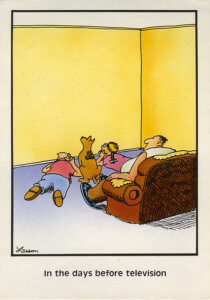This issue’s post

How to make real eye contact on Zoom
- Why do videoconferences always feel “off”?
- What is the TV anchors’ trick against this?
Why do videoconferences create that weird feeling of never being able to make a fluid and natural contact with the people you’re talking to? There’s always something off, a feeling of being out of sync… The information gets through, for sure, but in terms of human relations, the experience remains mediocre.
And yet when you think of TV presenters, even though there is no interaction, the quality of our experience is much better: you almost feel connected! Look no further: it’s all in the eyes. And more precisely, it’s the way these broadcasters make eye contact… with nobody!
A television pro looks at the camera when she speaks. In fact, while watching our TV, her eyes seem to stare at us. For her part, to give more warmth and authenticity to her facial expression, she tries to visualise an audience. A family. A loved one. Whatever suits her best, in fact.
Because it’s been like this for millions of years, eye contact is the precursor of any exchange. It says to the other: “I am here. I see you. Let’s share.” From now on, to establish more authenticity during your online exchanges, look only at the camera when you speak. Don’t talk to the “image” of the audience on your screen. And suggest they do the same.
What else?
Why is it that when someone speaks to us, words are less important than the rest?
- In an oral communication, people don’t pay attention to words first
- This comes from our time as cavemen/women
If we were to watch a film and turn off the sound, we would not necessarily miss the point. We would still be able to decipher, understand or be surprised by the human adventure unfolding before our eyes. Conversely, when we read a script that has yet to be shot, it is extremely difficult to get swept up or to grasp the nuances and power of the story.
This is due to the importance the words have relative to the totality of information that comes to us when we listen to someone. For millions of years, we lived without structured language, and our only concern was to be able to ‘read’ the intentions of the person – human or animal – coming towards us: “friend or foe?”
Even today, our DNA bears the mark of this survival mechanism. Thus, when we perceive a dissonance between words and behaviour, our attention immediately turns to any signal that could help us understand the true agenda of the person. In a way, the speaker is doomed to believe in what he or she is saying, otherwise the experts that we are will quickly spot that something is amiss.
If your gestures, energy, body language and tone are in line with what you are saying then, and only then, will people really listen to your words.
What’s in it for you?

Even in the office, our language betrays us
- Transactional Analysis describes the games we play when we talk
- Our language indicates which of these games it is
In his model of communication – Transactional Analysis – Eric Berne1 proposed that we essentially adopt three positions in our exchanges with others, which vary according to the context, the conversation and the person with whom we’re speaking. Put very simply, we either play the “Parent” (Critical or Nurturing), or speak as a “Child” (Free, Adapted or Rebellious), or we take an “Adult” attitude. The names of these ‘states’ speak for themselves.
The words we use are often an indicator of the state we are in. For example, the Critical Parent: “You, Should, Fault, Responsibility, Good, Bad, Not, Incompetent, Incapable, Look, Listen…” Or the Nurturing Parent: “Don’t worry, No problem, Of course you can’t, I’ll do it…”. The Child (and its three variations) might say: “I want, Now, Brilliant, Unfair, Never, Yes, all right, I can’t, I won’t, Nothing to do with me, So what?”.
The Parent and Child positions – usually slipped into unconsciously – often trap us in a communication style that is unproductive and stressful in the workplace. And it is recommended that when we realise this, we return to the Adult state where one simply states facts, without judgement: “This is, Why, We need to, Where?, What?, Let us, Because, So, Given, No, Sorry, You can…”
What is important, of course, is not to watch yourself all the time or to avoid a whole list of words, but to become more aware of the nature of your relationships with others at the very moment of the interaction (and not just when the shouting is over). When you understand what is going on, you can at least choose to do something about it… or not.
(1) Berne, E. (1961) Transactional Analysis in Psychotherapy. Grove Press, New York.
 Najberg Milne
Najberg Milne



